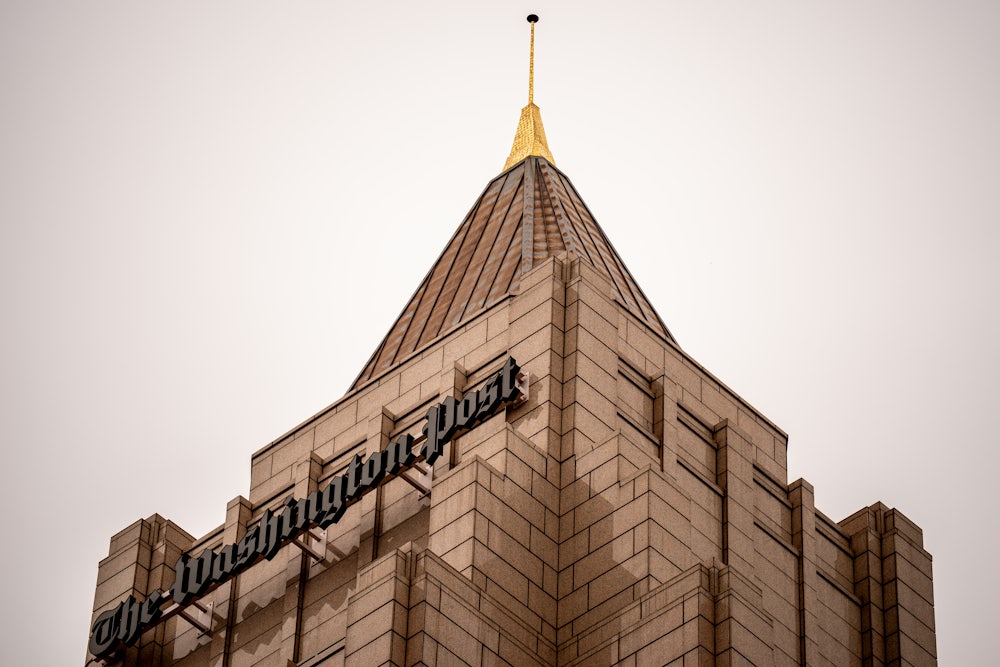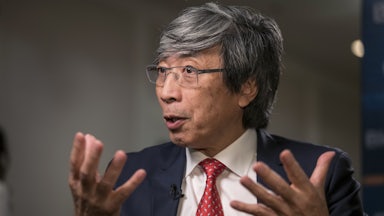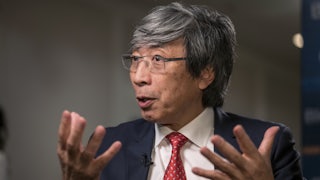Nothing is a given anymore in the journalism industry. It’s a presidential election cycle filled with history-making headlines that should translate into financial riches for the organizations covering them. And yet the industry is still cutting back.
Just six short months into the year, and the nation has already lost hundreds of media jobs and effectively shuttered several major news organizations at every angle of coverage, from Sports Illustrated to Pitchfork and VICE. In the midst of the uncertainty, newsroom owners have turned to an unexpected source of expertise on the U.S. media landscape: British journalists.
The Washington Post scooped up Robert Winnett, deputy editor of Telegraph Media Group, in CEO and publisher Will Lewis’s long plan to replace Sally Buzbee. The Daily Beast, a liberal tabloid, is losing editor in chief Tracy Connor in favor of Hugh Dougherty, a Scotsman who most recently was a deputy news editor at The New York Post. He joins British magazine legend Joanna Coles, who took over the tabloid’s C-suite as chief creative director in April. And The Wall Street Journal, under the leadership of English journalist Emma Tucker, has cut dozens of staffers since her takeover in 2023—despite a highly lucrative deal with OpenAI and a surge in paid subscribers.
While Americans may be left scratching their heads at the sudden takeover, the Brits stepping into the job appear to have their own beliefs for their new workplaces—and they plan to bring more with them.
“We are the ultimate trophies for American billionaires,” Coles joked to The New York Times, informing the outlet that she has every intention of “loading up on Brits” at the Beast.
The logic behind the international hires is clear: As the journalism industry bleeds money, a fresh perspective could be just the thing to shake things up and bring in some much-needed cash. But the journalists operating under the swapped leadership aren’t so sure about the great migration across the pond. Across outlets, editors and reporters who spoke with The New Republic on the condition of anonymity expressed unease and anxiety, pointing disappointed fingers at the unclear reporting plans and reorganized newsroom structures proposed by their new leaders.
British journalists are among the first to acknowledge the stark differences between the journalism industry of the Old Country and the U.S. market. Fleet Street papers work in a smaller media ecosphere, which fosters a regional competitiveness that is only now beginning to develop in the United States thanks to a dwindling market. Their ethics differ too: The British tabloid press are notoriously aggressive, unafraid to publish half-truths, purchase scoops, or even toe laws in pursuit of extreme sensationalism. (In fact, the Post’s Lewis is currently facing backlash from his involvement in one such scandal.)
From an English perspective, American papers are “too slow, too ponderous, and [lack] urgency,” according to Emily Bell, the founding director of Columbia Journalism School’s Tow Center for Digital Journalism and former director of Guardian Media Group. British journalists also are generally paid much less than American journalists: Earlier this year, a job listing from the British royal family went viral when one of the world’s colonial leaders offered to pay 25,642.50 pounds per year—less than $32,000—for a communications assistant to help handle the fallout after seriously flubbing an announcement about Kate Middleton’s health.
“Americans think we’re less expensive and more cutthroat,” Anna Wintour, editor of Vogue since 1988 and chief content officer of Condé Nast, wrote in an email attempting to explain the British media invasion phenomenon to the Times. “British journalists also tend to be hardened. News is a rough-and-tumble business in the U.K.—has been for centuries—and so when American media companies feel they need to fight to stay relevant, or profitable, it’s perhaps natural that they’d look across the Atlantic.”
But the arrival of the rough and tumble crew has not been welcomed at all the companies they’re taking over—least of all the liberal tabloid founded by a Brit, The Daily Beast.
One editor at the Beast told TNR they feel “apprehensive” about Coles and Dougherty’s combined leadership. The paper has been unprofitable for a while and lost tens of thousands of dollars in 2023. Staff morale had already plummeted prior to the announcement of Connor’s exit, as fears consumed the newsroom that another wave of layoffs was on its way. Some staffers reportedly were crying behind closed doors, and the editor who spoke to TNR wondered if stress about the future of the newsroom had played a role in recent illnesses that crept up on different employees in the last month.
So far, Coles’s directive for the newsroom remains unclear. The celebrity-obsessed editor arrived at the IAC-owned publication by way of Hearst Magazines, where she operated as the group’s chief content officer, and Cosmopolitan, which she ran as editor in chief. But her ideas for the Beast curiously include phasing out some of the publication’s main fare, transitioning away from political scoops—that, as former editor in chief John Avlon put it, “confront bullies, bigots, and hypocrites”—and other newsmaking content in favor of second-day news and evergreen SEO offerings.
The Beast editor called the British takeover across the industry “concerning, especially in an election year.”
“Ostensibly from right-wing publications, coming in to us and changing the editorial vision,” they said. “The big concern with all these Brits coming in is changing journalism ethics and just kind of a fundamental misunderstanding of American politics, right? They might not understand the intricacies of the American political landscape.”
The timing of these executive-level changes are also front of mind at the Post, where Buzbee’s departure last week—which one reporter described as “needlessly messy” and a former staffer described as “unceremonious”—left a bad taste in the newsroom’s collective mouth.
“She just got hustled out the door,” said the Post’s former media reporter Paul Farhi. “Her treatment was objectionable to people on the staff.”
Farhi and current staff also acknowledged that the timing of the replacement in the middle of a presidential election cycle was bizarre, describing the change as “shocking” and “absolutely baffling.”
“This becomes a distraction in the middle of a very busy time,” Farhi said. “Do you want to change horses right now, is the question.”
Lewis later issued a memo inviting staff to personally criticize his approach.
Buzbee was by no means one of the storied paper’s beloved editors. Her tenure was marked by deep tensions within the company since she was instituted as its leader in May 2021. But in addition to the newsroom generally feeling her exit was poorly handled, her departure also underpins a deeper issue plaguing the industry. Less than a quarter of top editorial positions are occupied by women, according to a global Reuters report released in March. Even fewer occupy the top positions at prestigious papers.
During a contentious and forceful meeting with staff in which he announced her departure, Lewis promised that the paper would make a renewed commitment to bringing more diversity to the newsroom—all while establishing a plan to bring in two white male executives, one of whom Lewis knew from his Fleet Street days. Buzbee, at the very least, had advocated for representation of women and people of color during her tenure.
And with Buzbee’s exit came a new business mandate. Long gone would be the days of a traditional newsroom for the Post, which just last year lost more than $70 million on its legacy model—enough to catch the unwanted attention of its billionaire owner, Jeff Bezos. In its place would be a new model, ominously dubbed the “third newsroom.”
In a press release, the paper’s corporate arm announced that the third newsroom would consist of “service and social media journalism” and would be run separately from the core news operation. The newly formed newsroom would turn to video storytelling, employ flexible payment methods, and, suspiciously, “embrace AI.”
“The aim is to give the millions of Americans—who feel traditional news is not for them but still want to be kept informed—compelling, exciting and accurate news where they are and in the style that they want,” the release read.
The Beast editor noted that the language was alarmingly close to the news model used by the far-right outlet The Epoch Times, which last month was indicted by the Justice Department for fraud for operating an auxiliary arm to its newsroom known as the “make money online” team. But the in-house reaction was more confused, with one anonymous reporter who had been with the Post for several years explaining that the way the project was marketed to the newsroom didn’t “make a lot of sense.”
Concerns about ethical quandaries posed by the new management led 600 members of the Post’s newsguild to issue an open letter to one of the paper’s incoming leaders, Matt Murray from News Corp, inviting him to “publicly state in a note” that the journalistic work of the paper would not be compromised by “other pressures, whether they are external or come from within the company itself.”
The notion that newsrooms are scrambling for new ways to make money during an election cycle is an alarming one. By all historical indicators, 2024 should be a record year for profits in the media industry. Previous election cycles have proven to temporarily bolster digital advertising revenue, lubricating the slow-dying industry’s coffers. But as the “Trump Boom” cools down, advertisers have become increasingly averse to news content.
This year, podcasts saw a 6.7 percent year-over-year decrease in total advertisers on their platforms, as news content is increasingly viewed as a “controversial space.” Gina Garrubbo, president and CEO of NPR subsidiary National Public Media, told Digiday that she wasn’t counting on the same “election year bump” that the radio industry had enjoyed in recent presidential election cycles—and she wasn’t the only executive anticipating a belt tightening.
“I think that clients who have previously felt uneasy about news and politics tend to maintain that level of unease, particularly during election years,” Gretchen Smith, vice president of media at Ad Results Media, told Digiday. “I noticed this trend among previous clients during the 2016 and 2020 election years, particularly Fortune 500 companies. It is not strictly a podcast problem, as politics heavily intersects with culture, and this often raises concerns for advertisers who are already weary.”
And while advertisers are backing away, readers are too. A Pew Research Center study published in May found that while more than half of Americans are closely following the election cycle, they’re also sick of hearing about it. Interestingly, Republicans and independents who lean toward the Republican Party are more likely to be tapped into the news cycle this year than Democrats and liberal-leaning independents. But among both political cohorts, people are simply tired of seeing the news. Roughly six in 10 Americans told Pew that they were exhausted by the level of coverage—even five months out from the election.
If that’s the case, then all the British executives in the world won’t be able to turn the journalism industry around. Not to mention the fact that British media executives have failed to gain a foothold in the U.S. media landscape at U.K.-based outlets. The BBC, The Guardian, The Independent, and The Daily Mail have all taken a crack at entering the American market, but none have surpassed the popularity of their U.S. counterparts.
“So what does that tell you about British media management?” wondered Farhi. “Is it that much better than American media management? I don’t think so. I don’t think you can conclude that. So this notion that a Brit is going to come in and ride to the rescue of an American media organization because they’re so damn smart is a questionable notion.”
To illustrate that point, look no further than The Wall Street Journal, which has proven to be one of America’s most resilient papers. It has four million readers, digital subscribers have grown by 60 percent since 2019, and it’s still able to charge top dollar from advertisers looking to reach its influential audience.
Since Tucker took over the Journal last year, the financial broadsheet has started a painful reorientation toward a digital marketplace, with a new leader keen on making the most of the changing times.
“We don’t want to be the German car industry of news publishing,” Tucker joked during a meeting with staff at the paper.
The London native got her start at the Financial Times before entering the folds of Rupert Murdoch’s media empire. In 2007, she joined News Corp, then became deputy editor of The Times of London, and in 2020 took the helm of its sister paper, The Sunday Times.
Although Tucker had no prior U.S. media experience before taking the reins of the Journal, in the months since she took charge, she has reported that paid subscriptions and site engagement have both gone up. She also secured a $250 million deal with OpenAI, the creators of A.I. chatbot ChatGPT, to lease the publication’s material for five years. But despite the obvious success, the company has still chosen to restructure its newsroom, in what staffers believe to be a surreptitious effort to skirt union regulations and boot more employees after laying off dozens of reporters earlier this year.
In May, Tucker announced that the Journal would undergo some major editorial reconstruction. The paper’s regional bureaus would be shut down and consolidated under new verticals. In a letter to staff describing the initiative as a “reader-first strategy,” Tucker explained that the real estate desk would move under the finance and economics banner, that education would move to “life & work,” and that national affairs would fall underneath the enterprise umbrella.
“We are moving away from regional and local general news, and because of that we are eliminating some roles in U.S. News and Speed & Trending,” Tucker wrote, sending off longtime employees with just a couple of lines acknowledging that it is “difficult” to say goodbye to staffers who had contributed to the Journal’s reportage for many years.
But the vision hasn’t trickled down to her employees. One senior Journal editor who spoke to TNR was less than optimistic about the opaque transition, fearing that the restructuring could be weaponized by executives as another opportunity to cut back staff.
According to the editor, union agreements had effectively capped the number of possible staff cuts through the end of the year. Rejiggered desk assignments allowed the company to cut positions so long as they opened up new opportunities for those reporters elsewhere—but the reconfiguration also opened up the possibility of a loophole if the bosses chose not to bring those reporters onto the new teams.
“It’s extremely disappointing that the company continues to have layoffs when every quarter they’re making record profits,” Jodi Green, president of the local union representing the newsroom, told NPR. “We don’t understand the reasoning behind a lot of it, and it’s discouraging to our members and to morale throughout the newsroom and all of Dow Jones.”
“It doesn’t make sense to me why some of the best journalists in our newsrooms are being let go,” Green added.
Farhi noted wryly that it’s possible to “overrate the Britishness of it all.”
“They may not be the saviors that we think they’re going to be,” he said.










